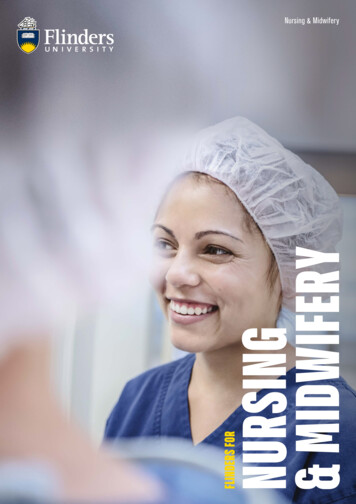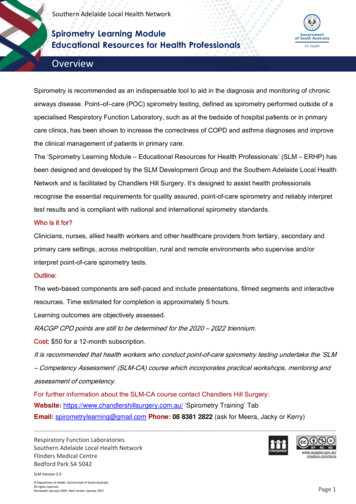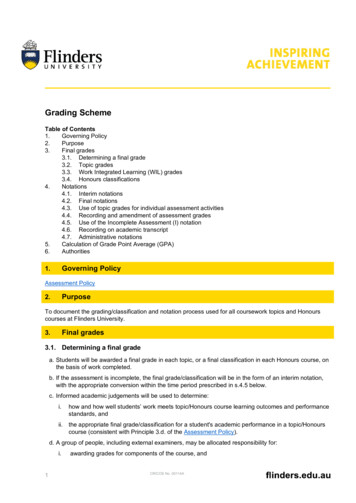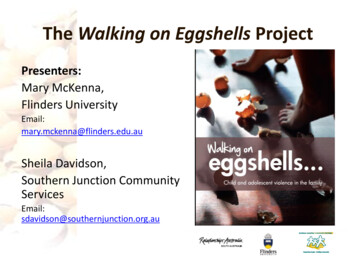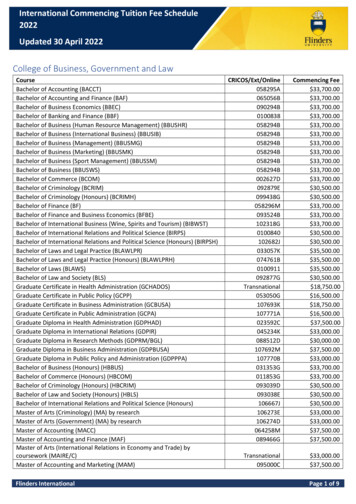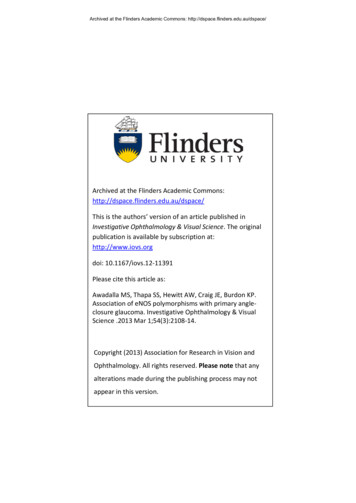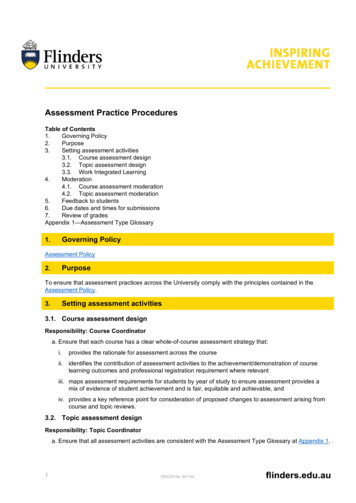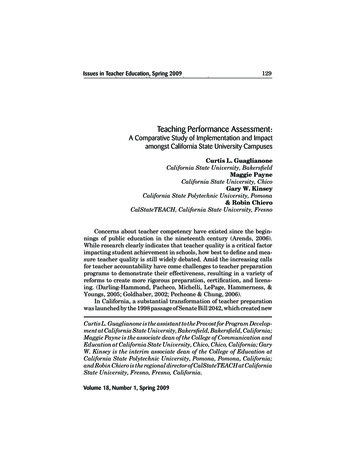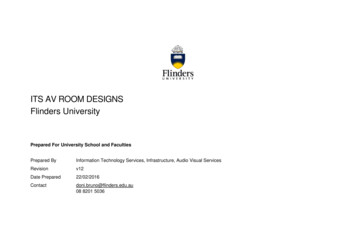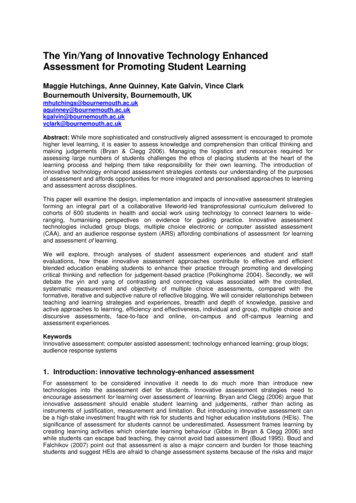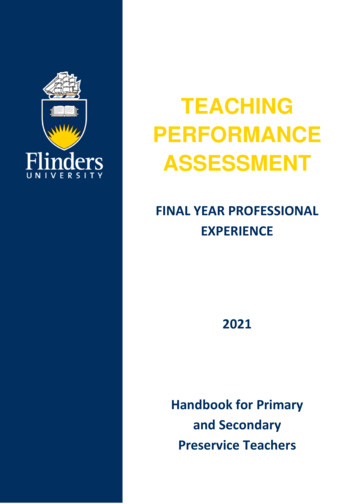
Transcription
TEACHINGPERFORMANCEASSESSMENTFINAL YEAR PROFESSIONALEXPERIENCE2021Handbook for Primaryand SecondaryPreservice Teachers0
From AITSLIn a teaching performance assessment (TPA), pre-service teacher illustrates their skills, knowledge andpractices through evidence of their performance aligned to the APST: Graduate Teacher Standards. In line withconcepts of authentic assessment, PST use evidence drawn directly from their own practices to demonstrate: what they want students to learn how they will facilitate this learning how they will know if students have achieved this learning (p.1).Retrieved pdf?sfvrsn 1410cb3c 61
TABLE OF CONTENTSIntroduction . 3Overview of the Assessment Task . 4Journal . 5Assessment . 6Evidence . 7Details of the Assessment Activities .9-14Activity 1. Self-assess your Professional Learning . 9Activity 2. Investigate the Context for Learning . 11The Planning, Teaching and Assessing Cycle. 15Details of the Assessment Activities . 16-32Activity 3. Plan for Learning and Assessment . 16Activity 4. Teach and Manage Student Learning . 22Activity 5. Assess, Provide Feedback and Report on Student Learning . 26Activity 6. Reflect on and Communicate your Learning and your Impact on Student Learning. 30Acknowledgements & References. 34APPENDIX 1: Video Recording Permission Form . 35APPENDIX 2: FU TPA Mapping to the Graduate Standards . 362
INTRODUCTIONThis document contains guidelines for successful completion of the Flinders University Teaching PerformanceAssessment (TPA). This is a major assessment requirement for the final professional experience placement.The activities are designed to authentically assess readiness for beginning teaching. The evidence gatheredfrom the six TPA activities can also be used for an ePortfolio which is part of the Capstone topic (EDUC4820/9401) assessment.The Six Activities1. Self-assess and plan your professional learning2. Investigate the context for learning3. Plan for learning and assessment4. Teach and manage student learning5. Assess, provide feedback and report on student learning6. Reflect on and communicate what you have learned about your teaching practice and your impact onstudents’ learning.Success Criteria Demonstrate teaching competency in relation to the Australian Professional Standards for Teachers at theGraduate Level Identify connections between the learning context and how this influences your planning, teaching andassessment Draw on students’ prior knowledge and learning to effectively plan and teach Increase students’ knowledge, skills, and understandings in specific curriculum areas Engage students in purposeful learning and monitor their understanding Assess student learning and determine patterns in whole class learning, as well as individual learningneeds Use student assessment data to inform your professional practice Critically reflect on your teaching practice and how this impacts students’ learning.3
Table 1 - Overview of the six assessment activities and the evidence to be collected.Activities 1 & 2 will be completed during the professional experience planning daysEvidence to be collectedActivity 1. Self-assess and Plan your Professional LearningJournalCritical reflective entries that identify and plan your professionallearning needsProfessional learning planGoal Setting Planner to create a succinct planActivity 2. Investigate the Context for LearningJournalEntries that identify the site/classroom contextand demonstrate understanding of your students, how they learnand your use of assessment data to inform planningBaseline DataClassroom standardised, diagnostic, continuous, observationaland/or curriculum-based assessment dataCase Study InformationCollect and consider specific demographic and baseline academicand engagement data about two students. One student hasminimal learning adjustments**, the other has specific learningrequirements or considerations (Connected to Activity 5,presented in Activity 6 and used in EPortfolio).**Inclusive and special education PST, please see personalizedinstructions for you, if you are teaching in a specialised settingActivities 3, 4 & 5 will be completed during the professional experience blockMinimum evidence to be collectedActivity 4. Teach and Manage StudentLearningActivity 3. Plan for Learning and Assessment1.2.3.4.Unit plan and 3-5 sequential lesson plansDifferentiated tasksPre-assessment or observational dataClass learning goals and intendedoutcomes5. Use of educational adjustments1.2.3.4.5.6.Video analysis of your teachingConstructive feedback from yourMentors/University LiaisonObservation data about use of ICT andmanaging challenging behaviourUse of ICT and other resourcesUse of varied communicationstrategiesAnnotated lesson planActivity 5. Assess, Provide Feedback andReport on Student Learning1.2.3.4.5.Analysis of whole class studentassessment dataReflections on the use of data andassessment to inform practice.Feedback from students andprovided to studentsRecords of student learning anddocumentation for reporting toparents/carersIn-depth analysis of assessmentdata - case study studentsActivity 6 will be completed after the professional experience blockActivity 6: Critical Reflection of your teaching and your impact on student learningEvidence to be collectedA PowerPoint presentation which brings together evidence from TPA Activities 1 to 5 addressing the criteria in presentation rubric (seepage 31). This activity will be conducted and assessed at Flinders University.4
JOURNALYou are required to keep a reflective journal for the duration of your placement, including planning days. Thejournal can be in digital or hard copy form. There are Discussion Prompts for each TPA activity which will guideyour journal responses. You may also reflect on lessons taught and other aspects of your teaching practice.Discussion Prompts: What did you plan to teach and why? What worked? What did not work? For whom? Why? What evidence supports your perceptions? What feedback did you receive and how will you respond to this feedback? How will you change or adapt your next lesson based on your knowledge of research, reflections andfeedback?Share your journal entries with your Mentor Teacher each week and with your University Liaison when they visit.IMPORTANT: Journaling is an effective tool for guiding critical reflection about your teaching practice and forsupporting the development of a personal theory of teaching. It can provide evidence of your professionaldevelopment and growth over time, and help you make sense of the connections between theory andpractice. While there is no ‘right way’ to journal, it is important that you explore and analyse yourobservations and experiences and not just describe them, to help you develop deeper understandings.5
ASSESSMENTActivity 1 will be completed before or during your planning days. Your University Liaison will assess the quality of yourevidence.Activity 2 will be completed during your planning days . Your University Liaison will assess the quality of your evidence.Activities 3, 4 and 5 will be completed in stages, during your block placement. Your Mentor Teacher will assess the quality ofyour evidence which also includes your classroom teaching practice.Activity 6 will be completed after placement at Flinders University. An academic panel will assess the quality of yourevidence.Rubrics are provided for each activity. These indicate, in consistent ways, what is expected of you. Your teacher mentor,University Liaison, and academic panel will use these to assess the quality of your evidence and where applicable, teachingskill and practice.ActivitiesAim to complete by:Assessed BySubmit on FLOActivity 1Final planning dayUniversity LiaisonNo later than two weeks after the finalplacement endsActivity 2Final planning dayUniversity LiaisonNo later than two weeks after the finalplacement endsActivity 3End of week 3 of block placementMentor TeacherNo later than two weeks after the finalplacement endsActivity 4End of week 4 of block placementMentor TeacherNo later than two weeks after the finalplacement endsActivity 5End of week 5 of block placementMentor TeacherNo later than two weeks after the finalplacement endsActivity 6Up to three weeks after your finalday of teachingUniversity PanelNo later than three weeks after final theplacement ends or as advised This timeline is suggested for PST who are completing a standard (40 days) metropolitan or countryblock placement. Dates to be adjusted accordingly, for those on internships or completing the extended 10week placement.To pass the final placement, pre-service teachers must demonstrate achievement at the Graduate Standardlevel or Towards Proficient level for all TPA activities and submit these activities on FLO by the deadlinesabove.6
EVIDENCEEvidence is authentic, reliable, and valid information that can be used to support a conclusion, claim ordecision. Evidence is directly observable and includes artefacts of practice, actions, and products of learning.For the TPA, you are required to systematically gather and curate artefacts and products of learning thatdemonstrate your learning and the effectiveness of your teaching skill and practice across your placement.Evidence will assist you to: Appraise your impact on student learning, wellbeing, and engagement Identify your successes and areas for growth Seek feedback and collaborate with colleagues to inform and improve your practice Plan for and engage in effective professional learning, relevant to your needs Discern how effectively you are demonstrating the planning, teaching, assessing, review cycle.What evidence do I provide?Table 1 details the minimum evidence to be collected and Table 2 provides examples of further evidence thatcan be collected, if desired, to highlight your practice.Please note: Preservice teachers are advised to meet privacy and confidentiality requirements when collectingevidence. This means you need to ensure you de-identify all evidence such as removing the names of studentsand parents/carers, the name of the school, teachers, and staff in your evidence.7
Table 2 – Further EvidenceCategoryExamples of EvidenceTeaching and learningEvaluation of teaching and learning programs; annotated individual studentlearning programs.programsResourcesClassroom displays, Assistive Technologies.ClassroomLesson observation notes; video clips of practice; notes of observations ofother teachers’ practice.observationsReflection andfeedbackStudent assessmentand learningCollaboration andcommunicationYour reflections on your practice; notes and feedback received from studentsand parent/carers; student survey data; student conference notes;performance review feedback from peers and/or supervisors.Assessment plans; assessment strategies; assessment records, student self/peer assessment feedback; deidentified samples of student work; feedbackprovided by you to students; assessment tasks and criteria; reflections on theuse of data and assessment to inform practice.Records of professional conversations and meetings; co- constructed resourceswith colleagues; team meeting notes; records of engaging with parents/carersand the community.Professional learningExamples of engagement in professional learning; evaluation of yourprofessional learning; action research; professional learning provided forcolleagues.OtherAnnotated school policies; variations to school routines; risk assessments.Adapted from AITSL. (n. d.). Demonstrating impact. Retrieved fromhttps://www.aitsl.edu.au/teach/ practice-workbooks8
DETAILED ASSESSMENT ACTIVITIESACTIVITY 1. Self-assess and plan your professional learning.PURPOSETo identify and plan your professional learning to achieve Graduate Standard level or higher in all focusareas.ACTIVITY 1Complete parts 1-3 during your planning days and part 4 during your teaching block.1. Use the Goal Setting planner tool, to document the evidence you have for each focus area and record thetypes of evidence you will need to gather to attain the Graduate level for all focus areas by the time yougraduate. /09/Planner-for-AITSL-GraduateStandards.pdf2. Next, create a succinct professional learning plan which makes explicit:1. The professional learning goals that you can achieve by the end of the placement block.2. The strategies and resources you will use to achieve your professional learning goals.3. The evidence you will gather and how you will demonstrate if you are making progress.3. Share your Goal Setting Planner evidence and draft professional learning plan with your mentor for earlyfeedback during your planning days. Adjust if necessary and create your final plan.4. Share your final plan with your University Liaison at the start of your block placement and reflect on yourprogress intermittently across your placement.9
Rubrics: Activity 1Assessed by the University LiaisonIn awarding Emerging, Graduate or Towards Proficient, assessors apply 'on balance' judgementAPSTDomain 3Professional EngagementStandard 6: Engage inprofessional learningFOCUS AREA 6.1Demonstrate anunderstanding of the roleof the AustralianProfessional Standardsfor Teachers inidentifying professionallearning needsFOCUS AREA 6.2Understand the relevantand appropriate sourcesof professional learningfor teachersEmerging(Standard not met)Identifies some professionallearning needs using theAustralian Professional Standardsfor Teachers Pre-service TeacherDevelopmental ContinuumEngages in self-reflection toproduce some evidence obtainedand needed for achievement atthe GRADUATE level using theGoal setting plannerGraduate(Standard met)Produces evidence obtained andneeded to achieve Graduatestandard for all focus areas usingthe goal setting plannerCreates a succinct professionallearning planAttends staff and curriculummeetingsContributes to staff and curriculummeetings where appropriateSeeks opportunity within theschool for professional learningParticipates in professional teamsto gather knowledge and practicerelated to some identifiedprofessional learning needsIdentifies sources of professionallearning to improve teacherpracticeTowards Proficient(Exceeded Standard)Use the Australian ProfessionalStandards for Teachers andadvice from colleagues toaccurately identify and planprofessional learning needsIdentifies ways professionallearning has improved theirpracticeParticipation in learning toupdate knowledge and practice,targeted to professional learningneeds and school and/or systemprioritiesDiscusses ways professionallearning has improved andrefined their practice10
ACTIVITY 2. Investigate Context for LearningPURPOSETo identify who the students are in your class and their learning requirements.To understand how classrooms/schools/community context will influence your planning and teaching.ACTIVITY 2: Recommended word count - 500 wordsPart A1. Investigate and document in your journal, how the school context, the characteristics of the students inyour class, the curriculum area/s you will plan and teach, the sequence of lessons and the resourceavailable to you, are informing planning and teaching. Additionally, think about these in light of ethicalbehaviour and practice around the teaching profession.2. Locate available whole of class student assessment data and analyse to inform your planning. This mightbe diagnostic assessment data such as Pat M, Pat R, Running records, and so on. It might be curriculumbased assessment data that shows how the class has achieved/performed in academic content. It might beobservational data which shows what the students know and can do in particular domains.3. Document your analysis in your journal and reveal your insights about what the students know and can doas a basis for thoughtful planning, teaching and student learning. The Discussion Prompts below may beuseful to guide this investigation.Part BCase Study Information (To be assessed in Activity 5 and Activity 6)In activity 6, you are required to show your impact on student learning in various ways. One important way isan evaluation of your teaching effectiveness at the individual student level. To help you gather the evidenceyou need, you are required to undertake a case study on two students in your class. The following providesadvice on how to select the students and what information you should gather.Start nowInstructions: Select two students for close examination. Student 1** is an individual in your class who does not appearto require specific educational adjustments, supports or considerations to participate and engage11
meaningfully in the learning program. Student 2 is an individual who requires specific educationaladjustments, supports or considerations. While not a requirement, it may be prudent to select a learner(Student 2) whose background or reason for requiring a particular consideration is an area where you havean identified evidence gap in teaching knowledge (see your goal planner). For example, teaching a studentliving with disabilities, gifted and talented learner, Aboriginal and Torres Strait Islander student, culturallyand linguistically diverse learner, student who is gender diverse, or a student who is affected by traumaetc. Ensure Student 1 and Student 2 are in the same class, and, in the class where you will be delivering yourunit and lesson sequence for Activity 3. **For PST teaching in specialised settings such as special schools,disability units or district special classes, student 1 will be an individual in your class who requires fewercomplex adjustments to access and participate in the curriculum on the same basis than student 2. Gather relevant assessment data on both students during your planning days. For example, currentliteracy & numeracy achievement data, observational data, content knowledge and skill plus anything elsethat seems pertinent to the individuals- discuss with your Mentor Teacher if you are not sure. In your journal, describe both students’ situation (case) and identify the key issues of the case. Plan anddocument your course of action for attempting to ensure both students achieve in a particular area, as aresult of your planned actions. Share your plan with your Mentor Teacher and adjust, if necessary. Look for moments across your placement to gather and reflect upon (as journal entries) formative dataabout learning progress, including any actions you have taken to improve or refine your planning andteaching.NOTE: CASE STUDY IS NOT ASSESSED IN ACTIVITY TWOAim to have all data required for Part A and Part B completed by the end of your planning days. This willensure you have time to analyse the data and make necessary changes to your planning and teaching. It willalso enable you to assess and evaluate your impact on student learning, over time (assessed in activities 5 and6). Lastly, make sure you regularly document student progress and outcomes (for both part A and B) and theinsights you are gaining about successful teaching, in your journal.12
DISCUSSION PROMPTSClassroom Context How many students are in your class? What is the ratio of boys/girls in your class? What is the cultural and religious diversity of students in your class? What languages do students speak?What religions? What resources are available to support students to learn? What opportunities exist for you to make a meaningful contribution to the school, classroom andindividual students?Student Development What are the physical, social and intellectual development and characteristics of students that may affecttheir learning? What have you observed about the students? What can students do and what are they still learning to do? How will you identify students’ prior knowledge and learning strengths and challenges? What student data is available and do any students have individual learning plans? Discuss the students’ abilities, how they interact with each other and express themselves.Planning Lessons Discuss and identify the subject/key learning area that you are going to teach and the sequence of lessons. What specific curriculum content will be assessed and reported and when? What teaching strategies will you use to meet the specific needs of students?13
Rubrics: Activity 2Assessed by the University LiaisonIn awarding Emerging, Graduate or Towards Proficient, assessors apply 'on balance' judgementAPSTEmergingGraduateTowards Proficient(Standard not met)(Standard met)(Exceeded Standard)Domain 2 ProfessionalPracticeStandard 5 - Assess,provide feedback andreport on student learningFOCUS AREA 5.4Demonstrate the capacityto interpret studentassessment data toevaluate student learningand modify teachingpracticeDomain 3 ProfessionalEngagementStandard 7 - Engageprofessionally withcolleagues, parents/carersand the communityFOCUS AREA 7.1 Understand and apply thekey principles described incodes of ethics andconduct for the teachingprofessionFOCUS AREA 7.2 Understand the relevantlegislative, administrativeand organisational policiesand processes required forteachers according to schoolstageIdentifies the types ofassessment evidence required toeffectively evaluate studentlearningAnalyses student assessment dataand identifies strengths and needsin students understanding of coreconcepts in learning areasWith assistance from the MentorTeacher is able to modify lessonplans based on evidencegathered through assessmenttasks and reflects uponimplication for practice.Identifies interventions andmodifications to teaching practiceas a result of analysis ofassessment dataUses student assessment data toanalyse and evaluate studentunderstanding of subject/content, identifying interventionsand modifying teaching practiceEvaluates lessons and modifieslesson plans based on evidencegathered through assessment tasksIs aware of the ethicalexpectations of the teachingprofession when makingdecisions.Communicates effectively withcolleagues, and other membersof the school communityExplains how assessment data hasbeen applied to planning andteaching practiceDemonstrates knowledge of therelevant codes of ethics thatunderpin the educational contextMeets codes of ethics andconduct established byregulatory authorities, systemsand schoolsReflects critically on personal andprofessional practiceCommunicates effectively andinteracts professionally withcolleagues and other members ofthe school communitySeeks out relevant legislative,administrative and organisationalpolicies and processes,particularly when planningstudent activities.Seeks clarification and complieswith legislative, school and systempolicies, procedures and processes,including those related to disciplineand welfareCan explain mandatory reportingrequirementsFollows mandatory reportingrequirementsUnderstands the implications ofand complies with relevantlegislative, administrative,organisational and professionalrequirements, policies andprocesses14
THE PLANNING, TEACHING & ASSESSMENT CYCLEThere is strong evidence to suggest that when teachers understand and apply the planning/ teaching/learning/review cycle in their everyday planning and teaching, student learning is strengthened. Thoroughevaluation of what each student knows, understands, and can do, provides information that is essential toinstructional decision making and the creation of learning environments that support students to succeed.The Teaching Performance Assessment requires that you collect evidence of your ability to implement the fullcycle of teaching practice: Plan, Teach, Assess, Review/Reflect. The model below represents this organisationalflow and has been designed to help you make sense of the cycle and the TPA.········Plan teaching, learning and assessment withdifferentiationInvestigate educational adjustments, considerstudent needs and determine what will facilitatelearning for your studentsDevelop learning intentions and outcomesDevelop effective assessments to monitorand support student learning /stageof the learning processPlanDetermine resources including(ActivityICTThree)GroupingsReflect on your practice andstudent learningExamine class and individualstudent achievement data,review student work and plan vityFour)Assess(ActivityFive)····Teach unit and lessonsequencesAdjust as required, in responseto student learning (support,engagement and learningprogress)Apply formal and informalassessments to collectinformation about progress oflearnersProvide and use feedback toguide learningUndertake summativeassessment15
ACTIVITY 3. Plan for Learning and AssessmentPURPOSETo demonstrate your ability to design unit and lesson plans, with a focus on specific anddifferentiated student learning outcomes. To demonstrate your ability to organise contentand consider effective teaching strategies in teaching areas.ACTIVITY 3: Recommended word count - 500 words1.Using your knowledge of your students and how they learn, develop a comprehensive unit plan anddesign at least three sequential, differentiated lessons plans/tasks that demonstrates consideration ofplanning, teaching and assessment for diverse learners. Prior to teaching the unit and lessons, consider usingthe Discussion Prompts to begin a conversation with your Mentor Teacher about the appropriateness of thisunit and sequence of lessons for this class. Record suggestions and improvement feedback on your unit andlesson plans.2.Critically analyse your teaching plan (unit and lessons) and Mentor Teacher improvement feedback, todemonstrate your understanding of the students and the curriculum to plan for and implement effectiveteaching and learning for the entire class.3.Document your analysis and insights in your journal.4.Go to Activity 5. Read the requirements around designing a summative assessment tool with criteria thatwill capture and measure the intended learning from this unit of work. It is recommended that you developyour whole-of-class rubric (or whatever assessment tool is appropriate for this unit of work) now, so that youhave this ready for Activity 5.DISCUSSION PROMPTS What is the central teaching focus of your unit and planned lessons? Why is the content important for students to know? What concepts are you teaching? How will your teaching align with current curriculum documents (e.g. Early Years Framework, AustralianCurriculum, International Baccalaureate, SACE)?16
Theoretical and Pedagogical Framework What are the theoretical frameworks/learning theories/ pedagogical models and/or research/ readings thatinform your unit design and lesson planning? For example, The Teaching for Effective Learning Framework fective-learning; Universal Design for Learning, Differentiatedinstruction (Tomlinson, 2019) etc.Learning Activities How will your knowledge of the students inform your lesson plans? How will your lessons develop students’ skills, knowledge and understandings of the learning area? How will you challenge all students to learn? How will you provide students with effective adjustments to access and participate in the learning process?Teaching Strategies How will your choice of teaching activities, strategies, and resources (including ICT) be inclusive of students’backgrounds, readiness levels, development stages, interests and needs?Student Assessment When and how you will assess student learning? How will student assessments help you understand whether students have achieved the learningobjectives? How will you provide students with feedback to progress and monitor their learning?Parents/Carers How could you encourage parents/carers in the educative process?17
Rubrics: Activity 3.Assessed by the MentorIn awarding Emerging, Graduate or Towards Proficient, assessors apply 'on balance' judgementAPSTDomain 1 ProfessionalKnowledgeStandard 1: Know studentsand how they learnFOCUS AREA 1.1Demonstrate knowledge andunderstanding of physical,social and intellectualdevelopment andcharacteristics of students andhow these may affect learningEmerging(Standard not met)Graduate(Standard met)Towards Proficient(Exceeded Standard)Is aware that physical, social andintellectual development andcharacteristics of students mayaffect learning and attempts toapply this understanding whenplanning for and facilit
practices through evidence of their performance aligned to the APST: Graduate Teacher Standards. In line with concepts of authentic assessment, PST use evidence drawn directly from their own practices to demonstrate: . Evaluation of teaching and learning programs; annotated individual student learning programs. Resources Classroom displays .
